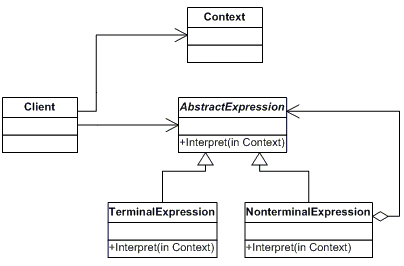解释器模式
Give a language, the Interpreter design pattern defines a representation for its grammar along with an interpreter that uses the representation to interpret sentences in the language.
The Interpreter Design Pattern provides a way to evaluate language grammar or expression. This pattern is used in SQL Parsing, Symbol Processing Enginee, etc.
UML Class Diagram

Context: This is a class that contains information that is going to be used by the interpreter ot interpret.
AbstractExpression: This is an interface that defines the interpret method which should be impletmented by the subclasses. This method takes the context object as a parameter. This context object holds the data we want to interpret.
TerminalExpression: This is a concrete class that implements the AbstractExpression interface. The TerminalExpression represents elements in the grammar that do not get replaced such as symbols.
NonTerminalExpression: This is also a concrete class that implements the AbstractExpression interface. The NonTerminalExpression represents elements in the grammar that do not get replaced such as symbols.
Client: This is a class that builds the abstract syntax tree for a set of instructions in the given grammar.This tree builds with the help of instances of NonTerminalExpression and TerminalExpression classes.
When to use the Interpreter Design Pattern in C#?
- Grammar is simple
- Efficiency is not a critical concern





【推荐】国内首个AI IDE,深度理解中文开发场景,立即下载体验Trae
【推荐】编程新体验,更懂你的AI,立即体验豆包MarsCode编程助手
【推荐】抖音旗下AI助手豆包,你的智能百科全书,全免费不限次数
【推荐】轻量又高性能的 SSH 工具 IShell:AI 加持,快人一步
· 无需6万激活码!GitHub神秘组织3小时极速复刻Manus,手把手教你使用OpenManus搭建本
· C#/.NET/.NET Core优秀项目和框架2025年2月简报
· Manus爆火,是硬核还是营销?
· 终于写完轮子一部分:tcp代理 了,记录一下
· 【杭电多校比赛记录】2025“钉耙编程”中国大学生算法设计春季联赛(1)